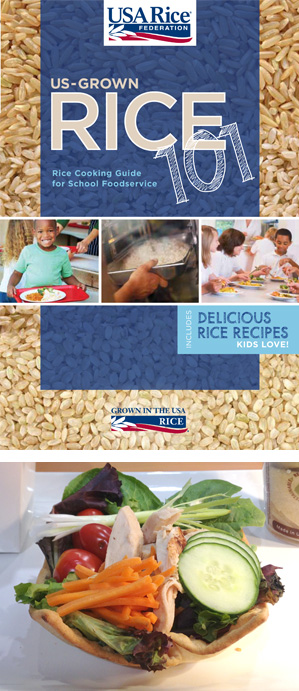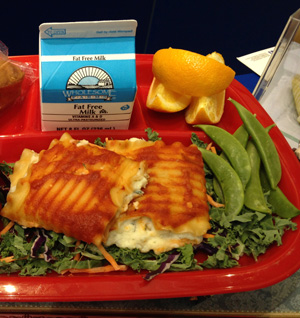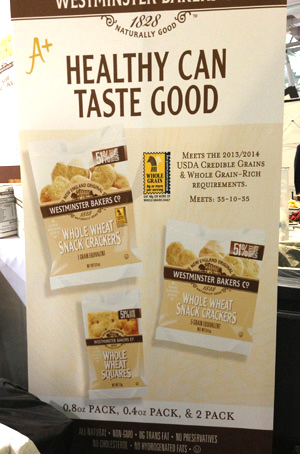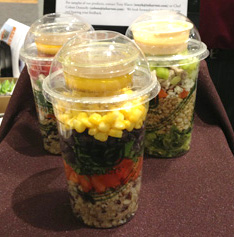Share This
Last week the annual convention of the School Nutrition Association descended on our hometown of Boston, so Mallory and I dashed over to see what’s new in the world of school food.
In a word (okay, two words) the answer is whole grains. As of July 1 of this year, virtually all grain-based foods served in schools are required to be “whole grain rich,” which means they must contain more whole grain than refined grain. With this new requirement kicking in just weeks before the convention, nearly every other booth sported a big sign proclaiming whole grains (and many featured our Whole Grain Stamp).
You’ve probably heard about this requirement – and maybe heard about the pushback from some schools, claiming there just aren’t enough qualifying products available (especially good whole grain pastas), that manufacturers haven’t stepped up to the plate, blah, blah. There’s a battle raging between Michelle Obama (backed up by a long list of other proponents of the new school food standards) and the SNA, which is lobbying to delay or roll back some of the improvements in school foods.
You wouldn’t know any of this wandering the SNA show aisles. We started attending this show in 2008 and what we saw this year represents a sea-change in providing better foods to our nation’s kids. Six years ago we saw booth after booth of corn dogs, pizza and sugary beverages with almost nothing I would have fed my own kids.
Today – while corn dogs and pizza haven’t completely disappeared — companies are making an effort to provide not only products but solutions and inspiration for school foodservice managers. We stopped at the USA Rice Federation booth, for instance, and saw their nifty Rice Cooking Guide for School Foodservice, designed to address the fact that many schools don’t have a full kitchen. What if you only have a microwave? An oven, but no stovetop? You can still cook rice from scratch, with this brochure, which explains how to get the job done with six different kinds of equipment. We like the way USA Rice is addressing one of the key barriers to better food in schools – inadequate appliances.
Other companies emphasized a raft of creative ways to use the same product multiple ways – a boon to schools that prefer to stock one basic food and still vary their menus. Rich Products, for instance, showed how their whole grain flatbread could be baked into a salad bowl, and how their whole grain biscuit dough could easily turn into mini-quiches, breakfast sandwiches and more.
We made a special point of looking for whole grain pasta, since USDA had asked us to help them find answers for schools who reported having trouble serving whole grain pasta, especially lasagna; the schools claimed the lasagna noodles would “melt away” when held too long on lunchlines.
We hope those schools have now discovered the whole grain lasagna noodle roll-ups we sampled at the Windsor foods booth, which held up beautifully at the show. We also spoke with WGC members at Barilla and Dakota Growers Pasta Company, both of which make quality pasta that will hold up under the less-than-ideal conditions of school cafeterias.
There’s still a lot of packaged, processed food at the SNA show, which in large part reflects the realities of all too many schools. Got a breakfast program? Most school breakfasts are served in the classroom, à la carte style from a rolling cart. It’s just plain easier to serve a piece of fruit and a breakfast bar or a bagel than to deliver scrambled eggs when you’ve got to trundle through the halls from room to room. Got a lunch program staffed by people with no culinary training, where kids get just 15 minutes to eat? You need grab-and-go foods. Got a vending machine in your school? New rules are kicking in for that too, and you need to find the whole grain crackers and popcorn to replace yesterday’s candy bars and soda pop.
Yes, in a perfect world every school would have its own garden (as in the Edible Schoolyard Project), every school foodservice worker would be trained in the culinary arts, every child would get nutrition and cooking classes, and lunch period would be 45-60 minutes.
But even though the school food world is still far from perfect, the tide is turning, as many of the other booths at the SNA show illustrated. Alongside the packaged food (which at least is whole grain rich and lower in sodium now!) fresh food was well-represented too, from watermelons, pears and bananas to carrots, mushrooms, eggs and more.
We ended the day at the InHarvest booth, where Chef Coleen Donnelly demonstrated how to bring all these growing fresh-food trends together with her Shaker Salads. InHarvest’s booth stood out as one of the few where school foodservice personnel could see how fresh foods – colorful layers of vegetables, fruits and intact whole grains – can be easily combined by staff with little culinary knowledge and little kitchen equipment, and packaged in a kid-friendly portable package. The kids get the fun of adding the dressing, and shaking it up to mix the ingredients – and then they can eat the salad right out of the cup.
We’re not there yet, but let’s appreciate how much things have changed. Districts are retraining their staff to do more scratch cooking (with the help of organizations like Cook for America). School boards are agreeing to move stoves and ovens back into the schools. We’re betting that when we walk the SNA show next year, we’ll see even more of this kind of innovation.
School food isn’t perfect yet – it’s better, and on its way to best. We can’t stop now. Let’s all keep pushing for continued improvements in the food we feed our kids. (Cynthia)





Add a Comment